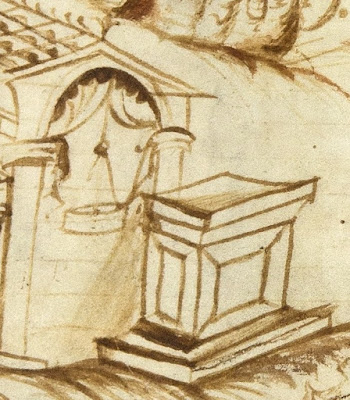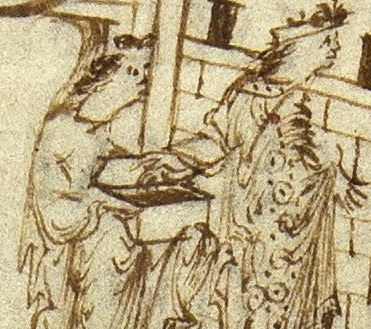As far as I know, there are only two extant medieval caskets with secular scenes on them. Perhaps there are a few more, but no matter the exact number, they are extremely rare, so there is not much to go on in trying to design a programme with a 9th century interpretation of a 12th century BC Greek myth. The fact that the story of Bellerophone and Pegasus was known to 9th century artists is proven by their inclusion in the mid 9th century Bible of Charles the Bald, as I demonstrated in my article covering the topic of carving the front panels for the box. (one scene from this story is also included in the Veroli Casket, in the British Museum) The illuminator who did those original drawings was most likely working from Roman or Late Antiquity (3-500 AD) illustrations or relief carvings that still existed in his time. I do not have the luxury of seeing what he had to work from, so I had to do what many medieval artists did, which was to look at the material I do have available, and adapt them to suit my interpretation of the story whilst making them fit the format of the panels which I am using.
| Five scenes from the beginning of the story sketched out and ready to begin carving; besides all the time for research, the actual drawing took more than ten hours. |
In the Württembergische Landesbibliothek (Württemberg State Library) is an early 9th century Psalter (known to medieval scholars and historians as the Stuttgart Psalter) which has a host of very fine illustrations. I chose this manuscript as my primary source of figures and inspiration for all of the remaining scenes which I will use for this box. In the first scene, Bellerophone approaches Proetus, who was the king in Tiryns, as told in the Iliad. He had just murdered someone, and came to the king for forgiveness. The second scene is King Proetus, and the third shows the king hosting a banquet in which Bellerophone is a guest. There is a break in the story, as the next scene will be on the lid, but the king's wife made advances on him which he rejected, and feeling scorned, she accused him of attempting to use her, (an oft repeated story very much like that of Joseph and Potipher's wife from the book of Genesis). King Proetus sent Bellerophone to his brother-in-law who was the king of a neighbouring country and asked him to "remove the bearer of these tablets from this world" for the crime of attempting to ravage his sister. That king also wined and dined Bellerophone before he bothered to read the message from his fellow king and thus was not willing to execute him, having shown him the hospitality of an honoured guest.
It is for this reason that I have chosen to include the two kings bracketing the banquet scene as it actually stands for both events in the story. Medieval illustrations are not nearly so linear and scene specific as what we modern readers are accustomed to in comic books and newspaper strips. In the first scene, behind Bellerophone, we see some buildings which can represent both the city of Tiryns, as well as the king's palace. Bellerophone is not depicted as "entering" the doorway, but rather gesturing to the king, as a way of progressing on to the next event in the story, thus multiple "events" and settings are often part of the same 'scene'. This is very common in medieval artwork as the following detail from an ivory panel demonstrates.
 |
| Scene from the Passion, depicting Judas attempting to return the 30 pieces of silver and hanging himself from a tree. |
In this detail from an ivory book cover now in the Milan Cathedral's treasury, Judas seems to be looking at himself hanging from the tree as he attempts to return the "blood money" which he took in exchange for betraying Christ. This 'multiple events in a single scene' was a very common phenomenon in art throughout the Middle Ages.
I chose a picture of King David from the Württemberg Psalter as my Bellerophone because he had the general stance and sense of movement that I wanted in my panel. The hands had to be adjusted, and the mantle was shortened a bit so as to accommodate the format of the scene.
 |
| Detail from folio 24v of the Württembergische Landesbibliothek Psalter |
I did the carving over the period of about one and a half weeks in my "spare time" (This is what I do for fun, when I am not "working") Here is a picture about 5 or 6 hours into the work.
The buildings were mostly inspired by those in the Milan panels and another 9th century panel in the Louvre, a detail of which is below.
 |
| Inspiration for my buildings from a 9th century ivory panel in the Louvre |
The style of the modeling for the figures was drawn from the Milan panel as well, as is shown below.
 |
| Trees and figures as inspiration for my panel |
Even though this holly that I am using is about the same colour as ivory, it is not ivory, and does not carve like ivory which is rather hard and can be scraped and polished to great detail. Holly is wood, which is fibrous; no matter how sharp the tools, it still will not produce the crispness which is achieved with ivory carving. I was feeling pretty good about my carving when I finished for the day, until I saw it enlarged on the screen. If you are viewing this on your laptop the image will be about one and a half times the actual size of the panel. looking at this picture I can see a lot of details which I need to try to refine a bit. Once the whole thing is finished and has a coat of blonde shellac on it, it will hopefully look a little smoother and more polished.
 |
| One scene (sort of) finished; four more to go. |





















